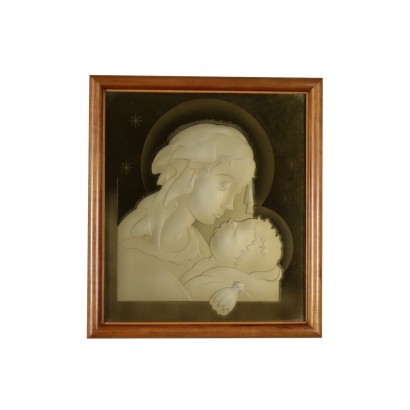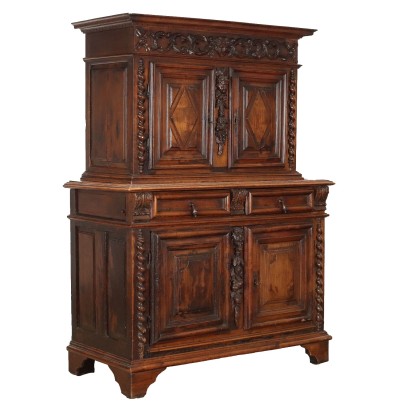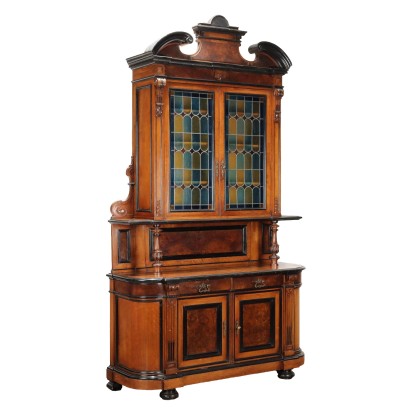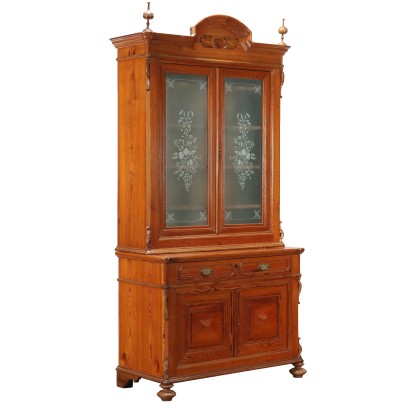Umbertine Rifle Cabinet Walnut Italy XIX Century - Italy, last quarter of the 19th century
Features
Italy, last quarter of the 19th century
Style: Umbertino (1870-1900)
Age: 19th Century / 1801 - 1900
Origin: Italy
Main essence: Walnut
Description
Umbertine fusilier in walnut carved on the uprights with zoomorphic heads, Italy, last quarter of the 19th century. Decorated with metal studs and leather inserts fixed on the gun holders, uprights connected by 2 crosspieces carved with mask, coat of arms and spirals.
Product Condition:
Object that due to age and wear requires restoration.
Dimensions (cm):
Height: 103
Width: 73
Depth: 40
Additional Information
Style: Umbertino (1870-1900)
The name of this style is due to the ruler of the time Umberto I appointed King of the Kingdom of Italy on January 9, 1878 and assassinated on July 9, 1900.The Umbertino style is typically Italian and belongs to that Eclectic period that characterized the second half of the 19th century, which lasted just under twenty years. The Umbertino style spread around 1880 and ended around 1895 when a new style called Liberty and universally known as Art-Nouveau took over, followed by Art-Decò.
In this style, predominantly eclectic and monumental, Gothic and Baroque elements originally belonging to the Renaissance but also adorned with large masks, frames and decorations were re-proposed in furniture, from the bedside table to the large wardrobe or sideboard.
Find out more about the Umbertino style with our insights:
An Umbertine secretaire dedicated to Dante Alighieri
A comparison between a Louis Philippe console and an Umbertina
INSERT ADDITIONAL LINKS:
The Austrian taste of Baroque
A guide to Art Nouveau
Discovering Art Deco
Age: 19th Century / 1801 - 1900
19th Century / 1801 - 1900Main essence: Walnut
Walnut wood comes from the plant whose botanical name is juglans regia , probably originally from the East but very common in Europe. Light or dark brown in color, it is a hard wood with a beautiful grain, widely used in antique furniture. It was the main essence in Italy throughout the Renaissance and later had a good diffusion in Europe, especially in England, until the advent of mahogany. It was used for solid wood furniture and sometimes carvings and inlays, its only big limitation is that it suffers a lot from woodworm. In France it was widely used more than anything else in the provinces. In the second half of the eighteenth century its use decreased significantly because mahogany and other exotic woods were preferred.Material:
Leather
Metal
Other customers have searched:
Oggetti antichi, vassoi antichi, scatole antiche, tazzine antiche, statua antica, oggetti antiquariato, oggetti collezionismo, quadro antico, oggetti anni '60, oggetti anni '70, oggetti anni '30, oggetti anni '40, oggetti anni '50..
Se ti interessano gli oggetti d'arte e antichi Scopri qui tutte le presentazioni degli oggetti più belli, eleganti e preziosi su FineArt by Di Mano In Mano
Leggi di più
Sull'antiquariato in generale dai un'occhiata anche a:
Classic Monday: da un pezzo dei nostri magazzini alla storia dell'antiquariato
L'antiquariato dalla A alla Z: il Dizionario dell'Antiquariato
Il dizionario dell'antiquariato - Lastronatura
Il dizionario dell'antiquariato - Mascherone
Il dizionario dell'antiquariato - Natura morta
Il dizionario dell'antiquariato - Opificio
Il dizionario dell'antiquariato - Pastiglia
Il dizionario dell'antiquariato - Savonarola
Il dizionario dell'antiquariato - Rosone
Leggi di più
Sull'antiquariato in generale dai un'occhiata anche a:Classic Monday: da un pezzo dei nostri magazzini alla storia dell'antiquariato
L'antiquariato dalla A alla Z: il Dizionario dell'Antiquariato
Il dizionario dell'antiquariato - Lastronatura
Il dizionario dell'antiquariato - Mascherone
Il dizionario dell'antiquariato - Natura morta
Il dizionario dell'antiquariato - Opificio
Il dizionario dell'antiquariato - Pastiglia
Il dizionario dell'antiquariato - Savonarola
Il dizionario dell'antiquariato - Rosone
Alternative proposals
It could also interest you












































